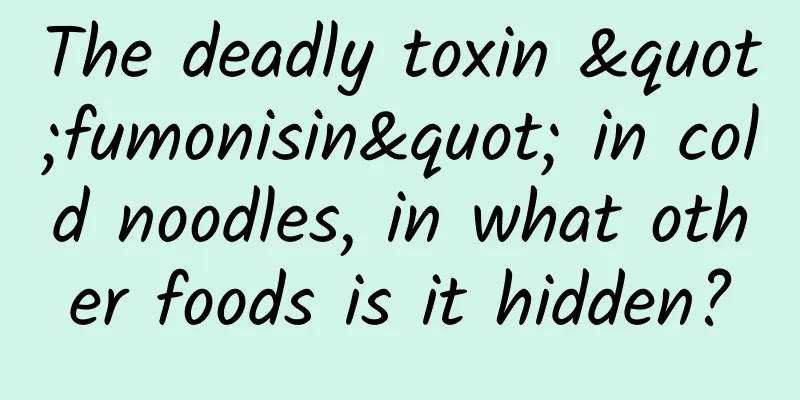The deadly toxin "fumonisin" in cold noodles, in what other foods is it hidden?

|
Recently, the news that one woman died and the other was injured after eating cold noodles became a hot topic on the Internet, sparking related discussions and causing panic among many netizens. The woman's family members said in an interview with the media that after testing, the two people were poisoned by fumonisin. What kind of poison is fumonisin? Can we still eat cold noodles? What exactly is fumonisin? Fusarium oxytocin is a toxin produced by the yeast Pseudomonas cereus subspecies, which is commonly found in foods that have been fermented or soaked for a long time. Pseudomonas cereus is widely distributed in nature and likes to grow on the surface of foods rich in starch. Hot weather will accelerate the growth of fumonisin Food is prone to produce fumonisin in a hot and humid environment. It is extremely heat-resistant and cannot be destroyed even after cooking at 100°C and high pressure. The mortality rate after poisoning is as high as 40% Currently, there is no specific antidote for fumonisin. Once poisoned, it can cause serious damage to important organs such as the liver, kidneys, heart, and brain, with a mortality rate of over 40%. The onset of fumonisin poisoning is rapid, and the incubation period is generally 30 minutes to 12 hours. If you experience diarrhea, abdominal pain, nausea, vomiting, or other discomfort, you must seek medical attention immediately. There are two theories about the cause of the poisoning: one is that too much borax was added to the cold noodles; the other is that the cold noodles were contaminated by bacteria and deteriorated, breeding the fumonisin toxin, which caused the poisoning. These foods can easily cause poisoning In addition to the foods mentioned above, there are 10 common foods that may also produce toxins. Let’s see how we can eat them safely? 1 Wild mushrooms In the wild, non-toxic mushrooms often grow together with poisonous mushrooms. Non-toxic mushrooms are easily contaminated by the mycelium of poisonous mushrooms. Even if you eat non-toxic varieties of mushrooms, there is still a risk of poisoning. 2 Excessive intake of ginkgo Ginkgo nuts contain substances such as hydrocyanic acid and ginkgolic acid. For infants under one year old, 10 nuts can be fatal. 3 Red sugar cane Red sugarcane indicates that it has gone moldy. The 3-nitropropionic acid toxin in it is harmful to the nervous system. Eating it may cause nausea and vomiting at the mildest, and respiratory failure at the worst. 4 Fresh daylily Fresh daylily contains colchicine, which will be oxidized into the highly toxic dicolchicine after entering the human body, which strongly irritates the gastrointestinal tract and respiratory system. 5 Bitter melon seeds and peanuts When peanuts, melon seeds, almonds and other nuts turn yellow or black, or even taste bitter, they may have been contaminated by mold and produced aflatoxin, and should be discarded immediately. Aflatoxin is 68 times more toxic than arsenic and is classified as a Class 1 carcinogen by the World Health Organization's cancer research agency. 6 Rotten ginger Rotten ginger will produce safrole, which can induce esophageal cancer and liver cancer. 7 Uncooked green beans, string beans, and lentils Fresh bean vegetables contain natural toxins such as saponins and hemagglutinins, which are highly irritating to the human digestive tract mucosa and can cause gastrointestinal symptoms. Hemagglutinins exist in beans and have a coagulation effect. If they are not heated thoroughly, eating them can easily cause poisoning, with symptoms such as nausea, vomiting, and numbness of the limbs. 8 Raw soy milk When a lot of white foam appears during cooking, it is a "false boiling" phenomenon, when the temperature inside the soy milk is only 80-90°C. This "half-cooked" soy milk contains plant hemagglutinin, which can cause food poisoning. 9 Sprouted potatoes Sprouted or green potatoes contain a large amount of solanine. Excessive consumption can easily cause poisoning symptoms such as throat itching and burning, gastroenteritis, etc. 10 Sweet potatoes with black spots If black and brown spots appear on sweet potatoes, it means that they may have been contaminated by black spot bacteria, which will produce highly toxic substances such as sweet potato ketone and sweet potato ketone alcohol, which are harmful to the human body. |
>>: Magical things born from simplicity: Uncovering the origin of bioelectricity
Recommend
Original, pure, and magnificent! Explore China's least-known "no man's land"
Human civilization spreads across all continents ...
12 tips to attract new users!
Introduction: User operations are actually divide...
Mom's Body Shaping Class
Introduction to Mom's Body Shaping Class Reso...
How can copywriters avoid being self-congratulatory and gain users’ sense of social participation?
Think more about whether your article can get the...
Don’t be greedy for Yunnan mushrooms, these 6 kinds of mushrooms in supermarkets are also delicious and nutritious (with recipes included)
Since the beginning of human life, people have of...
Soapberry: I am a relative of longan and longan, and I am also the "cleaning master" in the plant world
Painted by Qi Yunzhi In early spring, tender goos...
How much does it cost to join the Shangluo Coupon Mini Program? What is the price for joining the Shangluo Coupon Mini Program?
How much does it cost to join a coupon mini progr...
Starbucks’ private domain operation method!
Starbucks China has more than 5,000 stores and mo...
Is it reliable to use a bracelet to monitor sleep?
Most people living in big cities now have more or...
What are the legends about the Qixi Festival? A collection of legends about the Qixi Festival
The Chinese Valentine’s Day is coming. It is a tr...
The archery of Ji Fa in "Feng Shen" has become popular, so it's a good opportunity to talk about archery in ancient and modern China
Recently, the movie "Fengshen" has beco...
Sweet potatoes from the countryside? They are sweet potatoes that are inspiring immigrants to China!
Sweet potatoes from the countryside? They are swe...
User operation: 20% life-saving, 30% winning, 50% leap
"Live streaming with goods" is undoubte...
How to use seed users to drive brand promotion growth?
Many brand companies have realized that to carry ...









